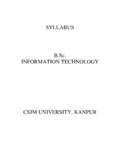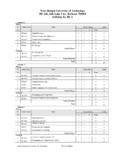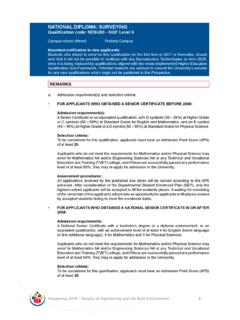Transcription of NTSYSpc - Exeter Software
1 NTSYSpc Numerical Taxonomy and Multivariate Analysis System Version User Guide F. James Rohlf Department of Ecology and Evolution State University of New York Stony Brook, NY 11794-5245 Exeter Software 47 Route 25A, Suite 2 Setauket, New York 11733-2870 Information in this document is subject to change. The Software described in this document is furnished under a license agreement (single-user or site license). The Software may be used or copied only in accordance with the terms of the agreement. Copyright 2000 by Applied Biostatistics Inc., 10 Inwood Road, Port Jefferson, New York 11777. All rights reserved worldwide. ISBN: 0-925031-30-5 Current printing: May 14, 2004 Contents 1. Areas of Program modules in How to get started using What s new in version What was new in version 2. Modes of Interactive Batch Both interactive and command 3.
2 Menus & related Main Customization Configuration options and Output Listing 4. Preparation of input data NTS file Examples of NTS Interface to other Excel Nexus 5. 6. Graphics options & General plot Other Plot iv 7. Typical Cluster Ordination analyses and Principal components Principal coordinates analysis, Nonmetric multidimensional Burnaby's method for size Comparison of v Preface NTSYSpc was developed originally for use by students in a seminar course Taxonomia n merica em microcomputadores held in September 1985 at the Esta o Agron mica Nacional, Oeiras, Portugal. Many of the programs were written on a portable computer as I worked each evening on the balcony of a hotel in Estoril trying to develop the programs needed by the students for the next day's lab projects.
3 The beautiful surroundings and enthusiastic students seemed to have helped. Most of the design and many of the actual programs were developed during the two-week course. It was quickly recognized that such a program on a personal microcomputer was of general interest both for use in student laboratories and for research computations. The PC was easily able to handle most datasets. NTSYSpc was originally written in FORTRAN for the IBM 360/50 mainframe computer at the University of Kansas in 1966. That version (called NTSYS) was developed with the help of Ron Bartcher who also converted it for use on a GE-635 computer in 1968. In 1969 John Kishpaugh and David Kirk helped with the conversion of NTSYS from the GE-635 back to an IBM 360/50 and then to the Univac 1100 computer system both at the State University of New York at Stony Brook.
4 In addition, many others contributed to its development over the years. But NTSYSpc is a new program written in Pascal. Fortunately, after all of the previous experience with conversions, most of the computational routines in NTSYS were by now quite system-independent and relatively easy to convert to another language. At present, NTSYSpc has moved beyond NTSYS and provides many operations not available in the version of NTSYS. NTSYSpc has gone through many revisions and has become much easier to use. The help files have been expanded and improved. They contain the technical information that was once in the printed documentation. Excel, the NTedit program, or any ASCII editor (such as Notepad) can be used for the preparation of data files. Both the program and the documentation have greatly benefited over the years by the help of many of the users who have spotted many glitches in the program and the documentation.
5 Drs. Dean Adams, Leslie Marcus, and Dennis Slice have made a number of important contributions. NTSYSpc will continue to be developed. New programs and features are planned so that the system can evolve to better meet your needs. Your comments, suggestions, and criticisms are appreciated. Port Jefferson, New York F. James Rohlf Introduction 1 1. Introduction Areas of application NTSYSpc is a system of programs that is used to find and display structure in multivariate data. For example, one may wish to discover that a sample of data points suggests that the samples may have come from two or more distinct populations. Of equal interest is the discovery that some subsets of variables are highly inter-correlated. The program was originally developed for use in biology in the context of the field of numerical taxonomy (which explains why the name of the program is NTSYS for Numerical Taxonomy SYStem).
6 But the programs have also been widely used in morphometrics, ecology and in many other disciplines in the natural sciences, engineering, and the humanities. The terms mathematical taxonomy and automatic classification have also been used to describe this field of application. The techniques also represent a subset of multivariate data analysis and have close ties to some methods in the field of pattern recognition. Within the field of systematic biology, one can distinguish two different approaches to classification. In phenetics one is concerned with the discovery and description of the patterns of biological diversity and forming classification based on overall similarity computed from multivariate data. These methods are commonly used in morphometric studies. In cladistics one is interested in inferring the evolutionary history of the organisms under study and using it as a basis for classification.
7 Specialized methods have been developed to take into account the assumption that the underlying model is of a branching evolutionary tree. It is expected that the best biological explanation of the observed diversity of a set of organisms will come in terms of their evolutionary history. The methods are intended to make the best estimates of the evolutionary tree given a set of descriptive data on a set of organisms. The most commonly used methods are justified on the basis of the philosophical principle of parsimony (that the shortest tree that can be fitted to a set of data should be the best estimate of the true tree) but statistically more powerful methods based on the principle of maximum-likelihood are increasing in popularity. The neighbor-joining method is also often used. The methods furnished in NTSYSpc are largely associated with the field of phenetics.
8 However, they are best interpreted as simply methods for multivariate data analysis. There are programs by others that are specialized for phylogenetic methods. Some of the better known ones are PAUP1 and PHYLIP2. However, Saitou and Nei's (1987) neighbor-joining 1 Written by David Swofford, currently distributed by the Illinois Natural History Survey. 2 Introduction method of phylogenetic tree estimation is included in NTSYSpc . NTSYSpc also contains specialized methods used in geometric morphometrics to study variation in shapes of objects. The principal journal devoted to the general theory behind many of these techniques is the Journal of Classification. It is published for the Classification Society of North America by Springer-Verlag. Theoretical papers are also published in many statistical journals.
9 applications of these techniques are published in many scientific journals in the areas of application. For example, Systematic Biology (formerly Systematic Zoology) has published many theoretical and applied papers with special emphasis to applications in biological taxonomy. Most users of these techniques begin with a data matrix that contains information about the properties (features, characters, landmark or outline coordinates, etc.) of a number objects (individuals, specimens, quadrats, OTUs, etc.). NTSYSpc can then be used to compute various measures of similarity or dissimilarity between all pairs of objects and then summarize this information either in terms of nested sets of similar objects (cluster analysis) or in terms of a spatial arrangement along one or more coordinate axes (ordination analysis or various types of multidimensional scaling analysis).
10 This User Guide assumes that the reader has some familiarity with the methods. It does not contain much advice about which similarity coefficient or which clustering method should be used. It does, however, give many hints about the use of the methods. To keep the account general, the neutral terms "object" or "OTU" (for operational taxonomic unit) are usually used to refer to the things (specimens) being analyzed and the terms "variable" or "character" are used to refer to the properties used to describe the objects under study. Users may find the following general references helpful (the complete references are given in the Bibliography). Everitt and Dunn (1992) give a good concise introduction to both cluster analysis and multidimensional scaling analysis. They furnish examples from biology.







